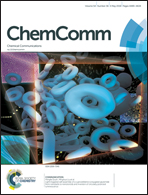Identifying the potential of pulsed LED irradiation in synthesis: copper-photocatalysed C–F functionalisation†
Abstract
It has been reported that pulsed irradiation can improve photosynthetic activity and phytochemical production in plants. Intrigued and inspired by these observations, we postulated that pulsed irradiation strategies may have broader implications in organic synthesis. We report here the results of a proof-of-concept study demonstrating that pulsed LED irradiation enhances the efficiency of a visible light-mediated photoredox-catalysed reaction. The design and construction of an inexpensive multiphase circuit (∼US$5) enabling power and pulse frequency modulation, which is connected to light-emitting diodes (LEDs), provides a source of pulsed visible light. This technology was then utilised to establish a novel copper-photocatalysed dual α-amino C–H/C–F functionalisation reaction. Pulsed blue LED irradiation was shown to be crucial for facilitating a much more efficient process and increasing the rate of product formation. Our results suggest that pulsed irradiation strategies have the potential to contribute to enhancing the synthetic utility and extending the scope of first row transition metal-based photoredox catalysts. We also anticipate that this approach will find wider applications in synthesis.



 Please wait while we load your content...
Please wait while we load your content...